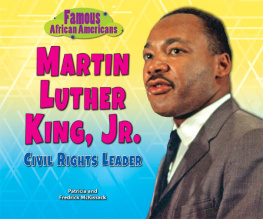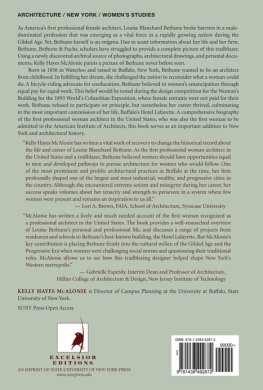A LOVE OF LEARNING
AS A LITTLE GIRL, MARY MCLEOD PICKED COTTON ON A FARM. ONE DAY SHE WAS ALLOWED TO GO TO SCHOOL. SHE LOVED IT! MARY BECAME A TEACHER AND STARTED HER OWN SCHOOL. SHE WORKED HARD TO MAKE SURE ALL AFRICAN-AMERICAN CHILDREN HAD THE CHANCE TO LEARN. READ ABOUT MARYS LIFE IN THE FAMOUS AFRICAN AMERICANS SERIES.
ABOUT THE AUTHORS

Patricia and Fredrick McKissack have written over one hundred books about the African-American experience. They have won countless awardsincluding the Coretta Scott King Awardand received much critical acclaim, all the while bringing enjoyment and information to young readers.

Image Credit: State Archives of Florida
Mary Jane McLeod grew up in this log cabin in Mayesville, South Carolina.
It was the summer of 1875. Patsy and Sam McLeods (sounds like Mac-Loud) fifteenth child was born. Her name was Mary Jane McLeod.
It was a happy time for the family. Patsy and Sam had been slaves. Mary Jane was their first child born free! That made Mary Jane McLeod special.
Mary Jane grew up in a large and loving family in Mayesville, South Carolina. She rode Old Bush, the family mule, to the fields. She picked cotton along with her brothers and sisters on her fathers farm.
One day Mary Jane went with her mother to a large house. Her mother washed and ironed for the people who lived there. Mary Jane had never been in such a big house. A young girl who lived there showed Mary Jane around.
There was a book on a table. Mary Jane opened it. Suddenly the girl took it away, saying, Put that book down! You cant read it anyway!
Mary Jane was surprised and hurt. True, she couldnt read. But why did picking up the book make the other girl so angry?
The McLeods had a Bible. Nobody could read it. That night, Mary Jane held the book in her hand. I will read! she said. God willing, I will read!

Image Credit: Ned O.
As a young girl, Mary Jane decided that she would learn how to read.

Image Credit: Ned O.
Mary Jane was the first person in her family to go to school.
One day Miss Emma Wilson came to Mayesville. She told Sam and Patsy about the school she was starting. Would they send Mary Jane to school?
Sam didnt think so. He needed everybody to help in the fields. Mary Jane prayed softly. Patsy spoke to Sam alone. At last Sam gave in. Mary Jane could go to school.
Mary Janes brothers and sisters were disappointed. Why couldnt she read after the first day in school? It took time. Before long Mary Jane did learn how to read and write. On one special night, she read the Bible to her mother and father. They were so proud.
Miss Wilsons school went to the sixth grade. A kind woman paid for Mary Jane to go to the Scotia Seminary in Concord, North Carolina. So in 1887 Mary Jane went away to school.

Image Credit: State Archives of Florida
As a young woman, Mary Jane wanted to teach and help others.
She was just twelve years old. It was so lonely at first. She missed her family very much. Seven years later Mary finished Scotia. Then she went to Moody Bible College in Chicago. Mary Jane McLeod was ready to start her lifes work. But what would it be? she wondered.
Mary wanted to teach in Africa. Instead she took a teaching job in Georgia. Good teachers were needed there.
Mary met Albertus Bethune. He was a teacher too. He made her laugh. They were happy together. In 1898 Mary and Albertus married. A year later, their son was born. His name was Albert McLeod Bethune. Everyone called him Bert.
Mrs. Bethune had heard that there was no school for black children in Daytona Beach, Florida. Mrs. Bethune went there.
I want to start a school for Negro girls, she said. All she had was $1.50. Some people laughed. Others helped.
Mrs. Bethune would not give up her dream. First she rented a small house. She found writing paper in the trash. She had to use boxes for desks and coal for pencils. It was a poor beginning.

Image Credit: Ned O.
Mary and Albertus Bethune enjoyed spending time together.

Image Credit: State Archives of Florida
Mrs. Bethune worked hard to start a school for black girls. Here she stands with her students.
But on October 3, 1904, Mrs. Bethune opened her school. She had five students. By 1905 the school had one hundred students and three teachers.
Next she bought land that had been the city trash dump. That is where she would build her school. Some people laughed. But others helped. Rich, important people gave money to help build her school and a hospital, too.
The first building for the school was finished in 1906. It was called Faith Hall, because faith had built it.

Image Credit: Moorland-Spingarn Research Center, Howard University
Mrs. Bethune was a good speaker. She spoke at churches and schools all over the country.
In 1923, Mrs. Bethunes school joined with Cookman, an all-boys school. Bethune-Cookman became a grade school, high school, and college. Boys and girls went to school together.
Mrs. Bethune was the schools first president. But to her students, she was always just Mother Dear.
Another name for Mrs. Bethune was The Black Rose. This is how she got that name.
Mrs. Bethune spoke all over the country. One idea she talked about was a big people garden. She said that people are like flowers. They live together in the world just as flowers grow in a garden. Red, yellow, small, tallall growing together. They are all different. But each one is lovely.

Image Credit: Ned O.
Mrs. Bethune dreamed of a people garden where everyone could live together in peace.
Once a child said to Mrs. Bethune that blacks couldnt live in the people garden. There were no black flowers! This made Mrs. Bethune feel sad. Just because you have not seen a thing doesnt mean it doesnt exist, she always said.
Years later she got a wonderful surprise. While in the country of Holland, Mrs. Bethune was given the bulbs of black tulips, the first black flower. And in Switzerland Mrs. Bethune was shown the black rose. This made her very happy. She ordered seventy-two black rose bushes. They were planted at Bethune-Cookman College. She also had black tulips planted at the entrance of her school.























